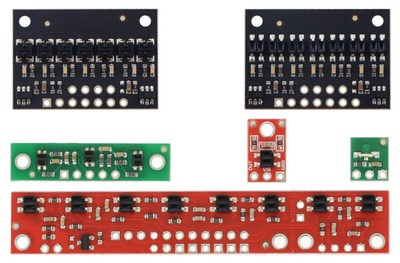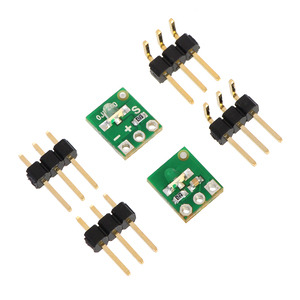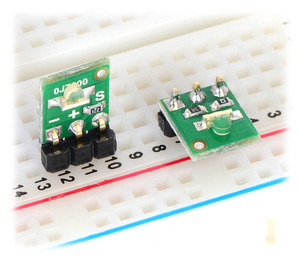The QTR-L-1RC reflectance sensor incorporates a right-angle infrared LED and a right-angle phototransistor in an inexpensive, tiny 0.35″ × 0.3″ module that can be mounted almost anywhere and is great for edge detection and line following. The output is designed to be measured by a digital I/O line. This sensor is sold in packs of two units.
Note: The QTR-L-1RC reflectance sensor requires a digital I/O line to take readings. The similar QTR-L-1A reflectance sensor is available with an analog output.
The Pololu QTR-L-1RC reflectance sensor carries a right-angle infrared LED and a right-angle phototransistor, both pointing toward the front edge of the board. The phototransistor uses a capacitor discharge circuit that allows a digital I/O line on a microcontroller to take an analog reading of reflected IR by measuring the discharge time of the capacitor. Shorter capacitor discharge time is an indication of greater reflection.
The LED current-limiting resistor is set to deliver approximately 17 mA to the LED when VIN is 5 V. The current requirement can be met by some microcontroller I/O lines, allowing the sensor to be powered up and down through an I/O line to conserve power.
This sensor was designed to be used with the board perpendicular to the surface being sensed, and narrow-angle lenses built into the infrared LED and phototransistor packages allow it to be effective to a range of about 1″ (25 mm). Because of its small size, multiple units can easily be arranged to fit various applications such as line sensing and proximity/edge detection. The QTR-L-1RC is sold in packs of two units.
For a similar sensor that can be used with the board parallel to the surface, but with shorter range, please see the QTR-1RC reflectance sensor. We also offer arrays of three and eight sensors: the QTR-3RC reflectance sensor array and the QTR-8RC reflectance sensor array.
 |
|
QTR sensor size comparison. Clockwise from top left: QTR-3RC, QTR-1RC, QTR-L-1RC, QTR-8RC. |
|---|
Specifications
- Dimensions: 0.3″ × 0.35″ × 0.12″ (without optional header pins installed)
- Operating voltage: 5.0 V
- Supply current: 17 mA
- Output format: digital I/O-compatible signal that can be read as a timed high pulse
- Optimal sensing distance: 0.125″ to 0.25″ (3 mm to 6 mm)
- Maximum recommended sensing distance: 1″ (25 mm)
- Weight without header pins: 0.006 oz (0.2 g)
Interfacing the QTR-L-1RC Output to a Digital I/O Line
Like the Parallax QTI, the QTR-L-1RC module has sensor outputs that require a digital I/O line capable of first charging the output capacitor (by driving the line high) and then measuring the time for the capacitor to discharge through the phototransistor. This measurement approach has several advantages, especially when multiple units are used:
- No analog-to-digital converter (ADC) is required
- Improved sensitivity over voltage-divider analog output
- Parallel reading of multiple sensors is possible with most microcontrollers
The typical sequence for reading a sensor is:
- Set the I/O line to an output and drive it high
- Allow at least 10 us for the 10 nF capacitor to charge
- Make the I/O line an input (high impedance)
- Measure the time for the capacitor to discharge by waiting for the I/O line to go low
These steps can typically be executed in parallel on multiple I/O lines.
With a strong reflectance, the discharge time can be as low as several dozen microseconds; with no reflectance, the discharge time can be up to a few milliseconds. The exact time of the discharge depends on your microcontroller’s I/O line characteristics. Meaningful results can be available within 1 ms in typical cases (i.e. when not trying to measure subtle differences in low-reflectance scenarios), allowing up to 1 kHz sampling. The following table shows some typical discharge times (from 5 V down to a 2 V threshold) of the sensor over different surfaces and at different distances:
| White surface | 3/4″ black electrical tape | |
|---|---|---|
| 0.25″ distance | 100 μs | 320 μs |
| 1″ distance | 160 μs | 260 μs |
Ambient light, especially sunlight, can affect the sensor readings significantly. If the discharge time of the QTR-L-1RC is consistently low, you might need to add shielding around the sensor or mount it in a different location to reduce interference from outside light sources.
Included Components
Each pack of two reflectance sensors includes sets of straight male header strips and right-angle male header strips, which allow you to mount them in the orientation of your choice. You can also solder wires, such as ribbon cable, directly to the pads for the most compact installation.
|
|



















